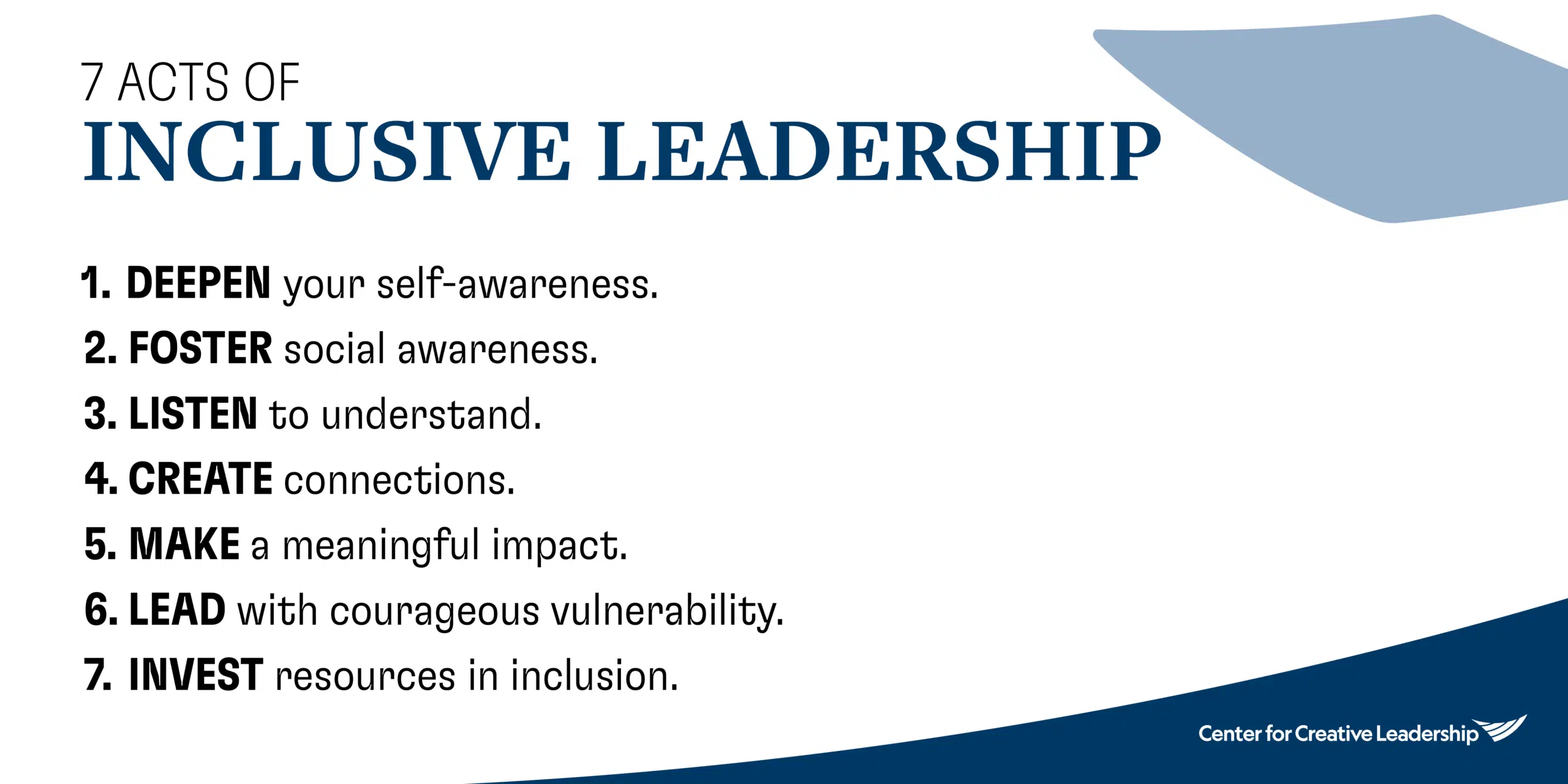What Does a Culture of Inclusive Leadership Look Like?
Across the globe, individuals aren’t the only voices demanding social and economic equality. Organizations, too, have taken a stand.
From corporations to small businesses to nonprofits, we’ve seen a range of responses aimed at denouncing racism and pledging commitments to greater equity, diversity, and inclusion.
As many senior leaders and HR executives reexamine their organizations’ diversity & inclusion initiatives, they are discovering that a reinvention may be in order. And that reinvention should start at the top, with leaders who embody an inclusive leadership approach.
But what exactly is inclusive leadership?
Inclusive leaders are individuals who are aware of their own biases and actively seek out and consider different perspectives to inform their decision-making and collaborate more effectively with others.
Inclusive leadership also means that leaders commit to ensuring all team members:
- Are treated equitably,
- Feel a sense of belonging and value, and
- Have the resources and support they need to achieve their full potential.
How to Practice Inclusive Leadership
Inclusive Leadership Starts With Compassion
First and foremost, compassionate leadership is of utmost importance for inclusive leaders.
Compassion is the foundation of our ability to understand what another is going through, connect with them on an emotional level, and take meaningful action to improve their condition. More than just showing empathy in the workplace, compassionate leaders move from a private place of empathetic feeling into external, tangible actions. Compassion should catapult you to do something meaningful — whatever that is for you or for other people — and it should show.
Inclusive leaders can encourage their colleagues to be more compassionate by practicing empathy and then consciously, intentionally engaging in acts of inclusive leadership.
When organizations commit to merging compassion and inclusion — and use that power to transform their cultures for the better — individuals adopt these 7 acts of inclusive leadership. These acts lead the way to full, meaningful, and authentic participation of every individual in the organization. Each act has the ability to change lives, open doors, and build bridges.
7 Acts of Inclusive Leadership
Whether you’re just starting out or the leader of an entire organization, engaging in these 7 intentional acts of inclusion and building the following leadership competencies will allow you to reinvent relationships and strengthen your organization.
1. Deepen your self-awareness.
As your first empowering act of inclusion, build a solid foundation of personal understanding, including about the power and privilege you may have access to. Sometimes this may mean asking for feedback; admitting to your own mistakes and failures; reflecting on your own upbringing, background, and social identity; talking about your emotions and experiences; or advocating for your own needs.
You need to have a high level of self-awareness; understand your own biases, strengths, and weaknesses; and be comfortable in your own skin in order to be able to engage in acts of inclusive leadership. If you’re comfortable with yourself, that confidence will reverberate through all the other acts of inclusive leadership. Learn how to boost your self-awareness.
2. Foster social awareness.
From self-awareness comes social awareness, a part of emotional intelligence, which is connected to leadership effectiveness. Social awareness is the currency of dialogue and our relationships with other people.
When people lack social awareness, they have trouble communicating, or tend to say the wrong things at the wrong times.
As you pay attention to what’s going on around you, use the information you gather to build a culture of inclusive leadership. For example, if a new person is hired, take some time to get to know them, show them around, and offer to help them get acclimated. Simple acts of inclusivity can help build a culture of respect at your organization.
3. Reveal blind spots.
In your daily interactions with colleagues, enable yourself to be exposed to new information. Be curious about experiences at your organization that are different from your own. Ask questions to learn more about other perspectives.
As we note in our article, 5 Powerful Ways to Take REAL Action on DEI, senior leaders in particular need to recognize that their organization isn’t a level playing field. That may or may not be apparent to you, but once you recognize that reality, you’re better equipped to take meaningful, substantial actions that make opportunities more accessible to all of your employees.
4. Listen to understand.
Listening is a powerful tool and, when used correctly, it can help the listener discover 3 things: the facts, plus underlying feelings and values.
As a leader, you have an opportunity to practice effective listening skills in everyday conversations, whether your employees are sharing personal stories or are enlisting your help in working through a challenging assignment.
By listening to understand, you go beyond active listening to get a more accurate picture of the challenges your team is facing. You’re better equipped to resolve conflicts, and you increase efficiency as well as inclusiveness and communication competencies.
Increase efficiency, improve employee commitment, reduce misunderstandings, and waste less time by upskilling your team so they truly Listen to Understand one another.
5. Create connections.
What’s the purpose of creating connections? A connection is a link that’s formed between people with the intention to strengthen, encourage, and improve their bond. Those connections help give you a more diverse social network, too. If you can build social connections, you will more likely have what you need when you need it, and connection is directly linked to employee wellbeing. On the other hand, when social connections are low, individuals run the risk of experiencing isolation, fear, mistrust, limited access to information, and negative effects on job performance.
In an organization, diverse social networks and a network-wide perspective are important because they invite information from different sources and perspectives. Those perspectives expand your capacity to deal with differences, especially in times of challenge or crisis. Just as you want your financial portfolio to be diversified, you also want your social networks to be diversified, because it makes you a more flexible, resilient, and agile leader.
6. Lead with courageous vulnerability.
Inclusive leaders lead with courageous vulnerability. In other words, they position themselves in the areas where they feel weak, and they do so courageously. They are also self-aware enough to be able to identify and share candidly about their own limitations. They seek input and ask questions, and they challenge others’ ways of thinking in a respectful manner.
A senior faculty member from our Equity, Diversity & Inclusion practice, Abigail Dunne-Moses, recounts an experience from early in her career: “I am a Black woman, and in my organization, we had a Latina who was extremely committed. Year in and year out, I saw her work tirelessly without getting promoted,” she says. “I felt for her, but for a long time I did nothing.”
As a fellow minority in the organization, Dunne-Moses felt vulnerable — and that she didn’t have a voice. “But the truth was that I did,” she says. “So I faced my vulnerability, I faced it courageously, and I spoke up on her behalf.”
Dunne-Moses had to express this courageous vulnerability 3 times, through continual conversations with management, but eventually, her vulnerability paid off, and her colleague was promoted. As a result of her persistence and willingness to practice allyship as a leader, Dunne-Moses was able to strengthen her organization by helping it to retain and advance a highly committed and engaged employee whose contributions were being overlooked.
7. Invest resources in inclusion.
Forward-thinking organizations understand that building a culture of inclusive leadership and diverse teams who collaborate well together takes a thoughtful investment of resources, but will offer a valuable return in the way of employee satisfaction and engagement, innovation capabilities, and increased ability to respond to complex challenges.
But how you invest in inclusive leadership matters. A recent study found that nearly 75% of employees in underrepresented groups — women, racial and ethnic minorities, and LGBTQ employees — do not feel they’ve personally benefited from their companies’ diversity and inclusion programs.
When Intentions & Impact Aren’t Aligned
Avoid Unintended Consequences in Your D&I Initiatives
When it comes to organizational diversity & inclusion initiatives, many leaders have good intentions to build diverse teams and practice inclusive leadership. But there’s often a gap between intentions and outcomes.
When diversity initiatives and inclusive leadership efforts go awry, organizations experience unintended consequences, such as individuals who don’t reach their potential and strategies that fall flat. And as others in the organization observe these consequences, trust levels begin to erode, the organizational culture suffers, and psychological safety at work is diminished for everyone.
At CCL, we help organizations take REAL, meaningful actions on diversity and inclusion to close the gap between intentions and actions, identifying specific steps to take given their particular context and challenges. These steps may include strategic initiatives, recruitment and performance management practices, diversifying networks, including others who may have specific needs to build belonging at work, and much more.
When individuals’ workplace experiences are driven by acts of inclusive leadership, the result is an organizational culture shift that reinforces true inclusion — a powerful transformation.
Ready to Take the Next Step?
We can partner with you to build a culture of inclusive leadership in your organization and shift mindsets, behaviors, and practices toward more equitable, diverse, and inclusive teams. Learn more about our Equity, Diversity, and Inclusion practice.










